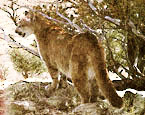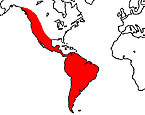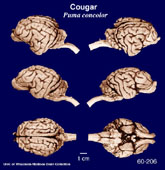|
Cougar
(Puma)
(Puma concolor) #60-206 |
||||
|
|
Physical
characteristics and distribution
|
|
The Cougar (Puma) is the largest of the small cats.
It is roughly the size of leopard with a very long
slender body. The head is round and small with brown
eyes. The head and body length for the mountain
lion ranges from 966-1,959 mm. The tail length ranges
from 534-784 mm, and the weight is 36-103 kg. There is no specific breeding season, but most births in North America occur in late winter and early spring. Females give birth every other year. Estrus lasts about 9 days, and the gestation period is 90-96 days. Litter size is one to six. Mating season is year round, but most births occur in late winter and early spring in North America. Young are born in protected dens in caves, under ledges or roots. By nature, pumas are active both day and night. They have become strictly nocturnal in areas inhabited by their enemies, humans and wolves. Their numbers have been greatly reduced by cattle ranchers. It inhabits mountainous coniferous forests, lowland tropical forests, swamps, grassland, and dry country, or any area with sufficient food and cover. There is usually no fixed den, except as used by females to rear young. Temporary shelter is taken in such places as dense vegetation, rocky crevices, and caves. They are located in Argentina, Belize, Bolivia, Brazil, Canada, Chile, Columbia, Costa Rica, Ecuador, Paraguay, Peru, Suriname, USA, Uruguay and Venezuela. |
|
Description
of the brain
|
|
Animal
source and preparation
|
|
All
specimens collected followed the same preparation
and histological procedure.
|
Other Related Resources (websites and publications)
List of Specimens | Explore Collections | Brain Sections | Brain Evolution | Brain Development | Brain Circuitry | Brain Functions | Location and Use | Related Web Sites | Contact Us | Search MSU Database | Personnel | Home



